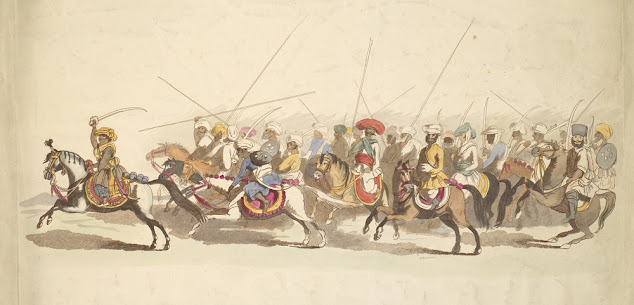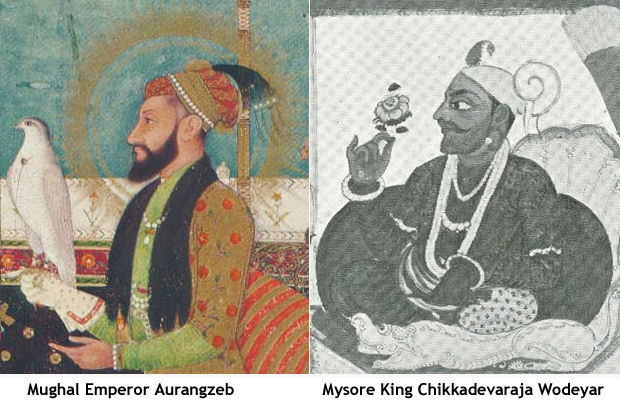Governments' lust for people's gold
The practise of Governments controlling the wealth
exiting the country is fairly well documented. The Moghuls from their early
days did so. There is documentation of how the Europeans vied for permissions
of the Delhi court to conduct trade in the Indian subcontinent (1). And Alamgir
Aurangzeb used the religious tax Jeziya as a tool to control the prosperous Hindu traders and pheasants. Apparently quite a few categories of people including the Brahmans were
exempted from Jeziya (2).
1700s
in Mysore Kingdom: People’s gold and invading armies
But ever since the earliest organised Governance emerged,
many Governments and rulers administering territories in what now is India have
had their lust for their subjects wealth go beyond the taxes they impose.
Surely there is no better way to control a geographical territory than through the
absolute control of the wealth of its subjects. Post Aurangazeb, a state of
anarchy prevailed in much of the subcontinent with kingdoms fighting each other
for supremacy. As the Mughals receded the Maratha armies topped the list of
native rulers successful in controlling the subcontinent’s largest geographical
area. There are records of the Mysore Wodeyars paying ransom to the Maratha
Armies each time the later invaded Mysore Kingdom and pillaged through towns
and villages (3), till Hyder Ali (father of Tipu Sultan) put an end to this in
1758. Despite the change in power, subjects still managed to save their wealth
thanks to the gold which they hid during raids of invading armies. The rulers knew
this. And hence the rulers also banked on the wealth of trading community in
their territories to fund their political survival. Hyder Ali borrowed a few
lakh rupees (of those days) from the wealthy traders of Bengaluru Pete as he
tried to regroup after his defeat by the Maratha army in early 1760s (4). And armies
invading other kingdoms adopted various methods to take away the personal
wealth of subjects. Edward Moor gives graphic details of the looting of personal
wealth in Mysore Kingdom by invading Marathas during the Third Anglo
Mysore War (5). When a Mysorean town was captured by the Marathas the residents would
flee with their personal wealth. They would wander as refugees from one hill
and jungle to another until the Maratha armies vacated their towns and villages.
The Marathas adopted a strategy at some towns. They would invite residents back
to a town offering them sanctuary if they paid a portion of their wealth. This
way they would identify those who had wealth and then strip them off their remaining
wealth.
1799
to 1947 - Brits and India’s gold
 |
| 'Tipu Sultan seated on his throne' by Anna Tonelli. From the Clive Museum at Powis Downloaded from Wikipedia on 1 Dec. 2016 |
Post Tipu Sultan’s death on 4 May 1799 his wealthy capital
Srirangapatna was looted of almost every single ounce of gold. This included his golden throne which was cut and distributed as a war spoil, apparently as it was too heavy to be carted off to England. The Brits removed the remaining thorns in their path to the
complete domination of India with little difficulty. And for the next 148
years, despite their taxation of ordinary people, the siphoning away of the sub-continent’s
resources they still remained interested in the personal wealth- the gold which
the ordinary Indians had saved. In the Raj era literature whenever the British touched
economics they rarely failed to mention the gold that Indians had (or ‘hoarded’
according to the Brits). Writing in 1891, John Hurst gives a good
insight to the gold which the Indians held on to so dearly (6). To quote him:
The
passion for acquiring jewels, instead of available property seems to continue.
It is probably an inheritance from the earlier generations of the unsettled
times. "I maintain." says Sundararaman, "that in every family in
this country there is a disproportionate amount of the fortune of the family
locked up in the form of jewels. There are families which can boast of 50,000
rupees worth of jewels, and often this amount is exceeded.
It
is a very ordinary thing that over a third of the possessions of a family which
has an estate of 10,000 or 15,000 rupees should be locked up in jewels. Even in
the poorest families, there exists this disproportion of jewels to possessions.
When Messrs. Orr & Sons put forth their advertisements in The Hindu
regarding Hindu ornaments, they are said to have realized in the very first
month a sale of over 20,000 rupees."
Unquote
Unquote
Katherine Mayo reaffirms the above almost 4 decades later
in 1927 and provides greater details of the people's wealth (7). To quote her:
‘A
third actual drain upon prosperity, seldom advertised, yet affecting not only
India but the rest of the world, is India's disposition of bullion. Since the
early days of the Roman Empire, western economists have been troubled over
India's intake of precious metals, rather than of foreign goods, in payment for
her produce. These metals she has always swallowed up.
In
1889 it was estimated that India held imprisoned "a stock of gold bullion
wholly useless for commercial purpose and increasing at the rate of nearly 3
million sterling [$14,000,000] annually, of the value of not less than two
hundred and seventy million pounds sterling [$ 1,312,000,000] ."
This
ever-accumulating treasure lies in the hands of all conditions and orders of
men, from the poorest laborer to the most eminent prince.”
Unquote
Unquote
Using
people’s personal wealth for state purpose
How can people’s wealth be tapped for state use? The
current government seems to be following in the footsteps of what foreign
economists had stated nearly a century ago.
Mayo reproduces an interesting statement of Don C Bliss, American
Trade Commissioner in Bombay
“Vast
reserves have been accumulated, . . . estimated as amounting to more than five
billion dollars but they have been jealously hoarded in the form of
unproductive precious metals. Put to productive uses, or loaned out in the world's
money-markets, they would suffice to make India one of the powerful nations of
the world. The traditional "wealth of the Indies" is there, but in
such a form that it yields nothing to its possessors.
From
time immemorial it has been considered improper for any great heir to draw upon
his father's hoard of precious treasure and equally improper for him not to
build up a hoard of his own. The late Nyzam of Hyderabad collected in his
vaults jewels to immense values. The present prince is understood to prefer
bullion, of which his own accumulations are said to reach to between 150 and
200 million dollars.
Equally,
every peasant in the land secretly buries silver in the earth, and loads it upon
his women's necks and wrists and ankles, for safe-keeping. Forty per cent, of the
world's total gold production, and 30 per cent, of the world's silver, is thus annually
absorbed by India. None
of this gold is coined or goes into currency, and, says Mr. Bliss, of silver:
"All of the absorption is in response to the demand for bullion for . .
ornamental uses."
"Undoubtedly,"
he adds, "an enormous quantity of bullion has been buried and
forgotten."
The
man heavily in debt to the bania commonly possesses a store of hidden coin, yet
continues borrowing. This custom rests on the idea of being prepared for the
rainy day and on a profound distrust of the human element in any scheme of banking.
The
tendency of the world's gold and silver to concentrate in India and there to
disappear from action tells its own story. On the one hand, an essentially poor
country could not bring such a thing about. On the other hand, no country that
buries its wealth and then lies down and sleeps on the grave can be really prosperous. - Unquote
 |
| A women displaying her gold bangles at a jewelry store in 2016 at Bengaluru, India Pic: Ameen Ahmed |
Post-independence successive governments have been trying
to use the personal gold and wealth of people for state use. This seems to have
acquired greater urgency in the past decade. The previous UPA Government tried
to attract the common man to invest his money in Gold ETFs by offering tax
exemptions on the same. Elected to power in 2014, the NDA took it a step
further by offering to keep people’s gold in exchange for gold bonds. There is
a distrust of the Government (irrespective of the party in power) hence all the
previous schemes and provisions to attract people to give their gold to the government
failed. This drastic step of making every Indian account for every single gram
of gold they have at home seems to be a product of this attitude of the common man.
Will this make the ordinary citizen trust the Government more by parting with her
or his gold (although there is no choice)? And will the Government retain the
trust by managing the state resources instead of squandering them to a select
few? Time will be a witness to it.
References:
(1) Jahangir giving permission to the Europeans to trade. Information at Ajmer by ASI.(2) Truschke, Audrey., 'Aurangzeb: The Life and Legacy of India's Most Controversial', 2017(3) Mark Wilks, ‘Historical Sketches of the South of India’, 1817.(4) Meer Hussein Ali Khan, Kirmani, ‘The history of Hydur Naik’, Translated by Col.W.Miles. 1842.(5) Edward Moor, 'A narrative of the operations of Captain Little's detachment, and of the Mahratta army, commanded by Purseram Bhow; during the late confederacy in India, against the Nawab Tippoo Sultan Bahadur', London, J.Johnson, 1794.(6) John Hurst, ‘Indika’, 1891(7) Katherine Mayo, 'Mother India' 1927(8) The Bombay Bullion Market, Don C. Bliss, Jr., U.S.Bureau of Foreign and Domestic Commerce, Trade Information Bulletin No* W, PP. 5-6.






Comments
Post a Comment
Thank you for visiting this blog and sharing your thoughts.